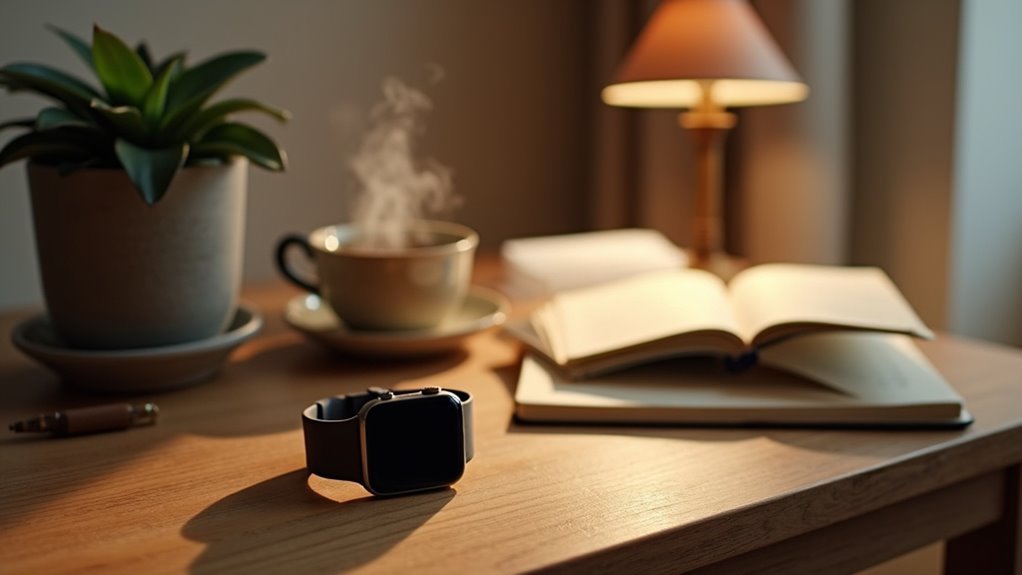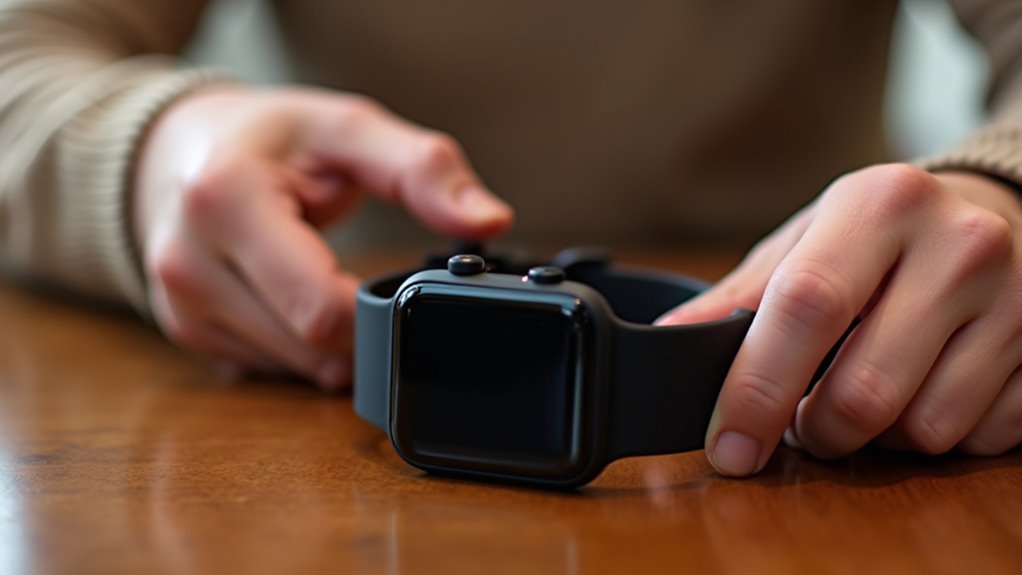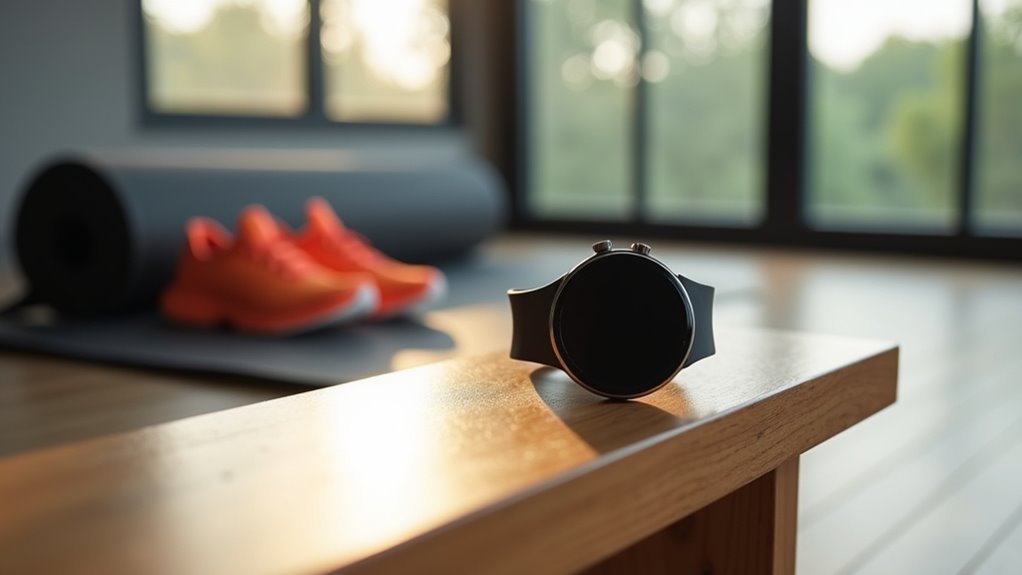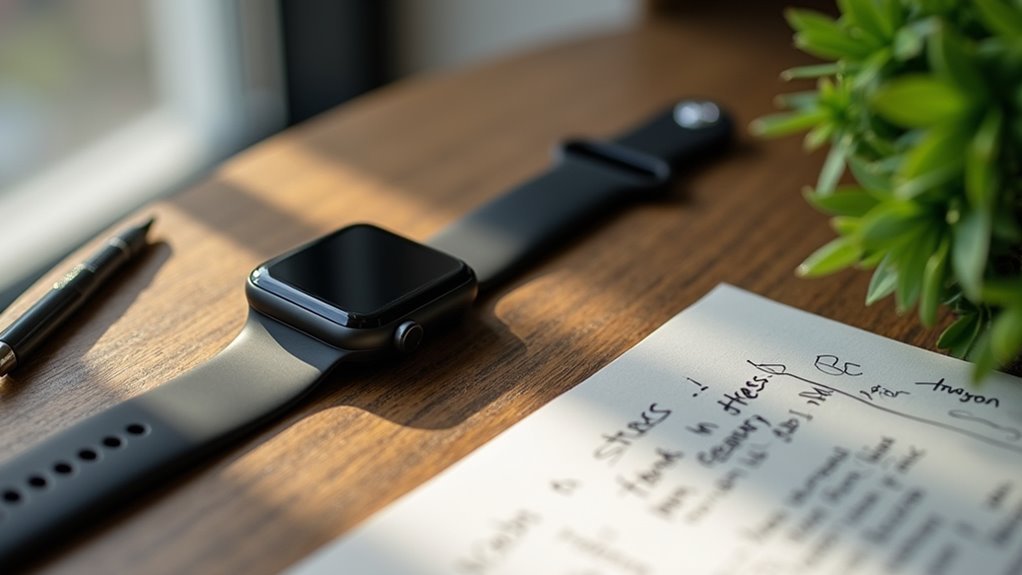You can boost your wearable’s stress tracking accuracy from 60-70% to over 95% by choosing validated brands like Garmin or Fitbit, maintaining consistent wrist placement one finger-width above your wrist bone, and enabling multi-sensor monitoring beyond just heart rate. Keep sensors clean, establish personal baseline data during calm periods, and focus on long-term patterns rather than single readings. Cross-reference device data with your own stress observations for better calibration and discover additional optimization strategies below.
Choose Proven Smartwatch Brands With Validated Stress Algorithms
When selecting a smartwatch for stress monitoring, you’ll want to focus on brands that have invested heavily in developing and validating their stress algorithms through clinical research.
Garmin stands out for its accurate stress tracking through HRV and Body Battery energy monitoring, providing personalized insights based on sleep and workout data.
Garmin delivers precise stress monitoring using HRV analysis and Body Battery technology for comprehensive health insights.
Fitbit’s stress tracking is validated through recognized HRV measurements, offering holistic health advice.
Polar excels in advanced HRV tracking with a focus on athletic performance.
Samsung uses HRV and heart rate to generate stress insights, including 24/7 summaries and an Energy Score feature, though it’s not as prominent as competitors. Since no universal metric for stress exists across wearable brands, each manufacturer interprets stress tracking differently.
These brands have undergone clinical validation through trials and studies, ensuring their algorithms are scientifically sound and reliable for accurate stress measurement.
Ensure Consistent Wrist Placement for Reliable Sensor Contact
Your smartwatch’s stress tracking accuracy depends heavily on where and how you position it on your wrist. Consistent placement guarantees reliable sensor contact, which is vital for accurate stress measurements.
Keep your device snug but comfortable, positioned about one finger’s width above your wrist bone on the back of your wrist.
PPG sensors in wrist wearables are sensitive to motion and skin conditions like tattoos or darker pigmentation. Maintaining the same position daily helps minimize these interference factors.
During exercise, consistent placement becomes even more essential as motion artifacts increase at higher activity levels.
Verify your band isn’t too loose or tight – proper contact prevents sensor gaps while maintaining blood circulation for peak readings. Environmental factors like temperature changes can also affect your device’s stress level detection capabilities.
Calibrate Your Device Settings Based on Personal Baseline Data

You’ll need to establish your personal health baselines by recording stress measurements during calm, resting periods over several days or weeks.
Once you’ve collected this baseline data, adjust your device’s sensitivity thresholds to match your unique physiological responses rather than relying on generic factory settings. Research shows that heart rate variations occur in 77% of participants during stress-inducing situations, highlighting the importance of personalized settings.
This personalized calibration guarantees your wearable can accurately distinguish between your normal variations and genuine stress responses.
Establish Personal Health Baselines
Because everyone’s physiology responds differently to stress, establishing your personal health baseline becomes essential for accurate wearable stress monitoring.
You’ll need to collect physiological signals like heart rate, skin conductance, and activity levels during calm, controlled conditions. Take repeated measurements over several days when you’re relaxed to create an average baseline that’s immune to temporary stress spikes.
Use self-reported calm periods or questionnaires to verify you’re capturing true non-stressed states. Automated algorithms can identify and remove outlier data that might indicate stress flare-ups.
Your baseline should exclude any acute stress episodes to avoid skewing results.
Update your baseline periodically as your physiology changes over time, and recalibrate if you suspect stress contaminated your initial data collection.
Adjust Sensitivity Thresholds
Once you’ve established your personal baseline, calibrate your device’s sensitivity thresholds to match your unique physiological patterns.
Your wearable’s emotional event thresholds are initially set empirically, but you can adjust them based on feedback following stress events. Remove any data corresponding to stress flare-ups during calibration, as this prevents skewing your baseline calculations.
If you experience stress during initial setup, repeat the calibration process during non-stressful periods. Your device uses this calibrated data in algorithms to predict emotional states and meltdown likelihood.
Provide feedback when stress events occur so your device can refine threshold settings automatically. Consider professional supervision for calibration, especially if you’re in specific demographic groups.
This customization helps your device better recognize your individual stress responses and improves accuracy. Advanced wearables can now detect changes in environmental conditions like humidity and gas concentrations, which may affect sensor performance and require recalibration under different conditions.
Enable Multi-Sensor Monitoring Beyond Just Heart Rate
While most wearables rely solely on heart rate monitoring, you’ll achieve far more accurate stress detection by enabling multiple sensors that capture a thorough view of your body’s stress response.
Heart rate variability (HRV) combined with electrodermal activity (EDA) and respiratory rate can boost stress prediction accuracy to 95%. EDA measures skin conductance changes from sweat gland activity, while respiratory patterns reflect autonomic nervous system responses. These physiological markers together create a detailed stress profile.
| Sensor Type | What It Measures |
|---|---|
| PPG/HRV | Heart rate patterns and variability |
| EDA | Skin conductance from stress sweating |
| Respiratory | Breathing rate changes under stress |
| Temperature | Skin temperature fluctuations |
| EEG | Direct neural stress indicators |
Enable all available sensors on your device for maximum accuracy. This multi-sensor approach provides real-time feedback that allows you to better understand your stress patterns and triggers throughout the day.
Maintain Clean Sensor Contact Points and Proper Fit

Your wearable’s accuracy depends heavily on maintaining clean sensor contact points and ensuring proper device fit against your skin.
You’ll need to clean your sensors daily with alcohol wipes to remove oils, sweat, and debris that can interfere with readings.
Additionally, you should adjust your band tightness regularly and monitor for any skin irritation that could affect both comfort and data quality.
Poor sensor contact can disrupt the measurement of key stress biomarkers like cortisol that wearable devices rely on for accurate stress assessment.
Clean Sensors Daily
Daily sensor cleaning forms the foundation of accurate stress monitoring, as sweat, oils, and debris can create barriers between your skin and the device’s contact points.
These contaminants interfere with signal quality, leading to inaccurate readings that can skew your stress data.
You’ll want to clean your sensors every day using a soft, damp cloth or alcohol wipe.
Focus on removing accumulated dirt and oils from the sensor surfaces where they contact your skin.
This simple maintenance step reduces noise and artifacts that compromise data accuracy.
Don’t forget to let sensors dry completely before wearing them again.
Regular cleaning also helps maintain healthy skin integrity under the sensor area, preventing irritation that could force you to remove the device and interrupt continuous monitoring.
Clean sensors enable wearables to collect the physiological data essential for developing accurate real-time stress predictions and personalized management strategies.
Adjust Band Tightness
Proper band tightness works hand-in-hand with clean sensors to deliver accurate stress measurements. Your wearable needs consistent skin contact to capture physiological signals like heart rate variability and electrodermal activity effectively.
If the band’s too loose, you’ll experience signal loss and gaps in data collection. Too tight, and you’ll compromise comfort, discouraging continuous wear that’s essential for reliable stress tracking.
Adjust your device so it sits snugly against your skin without causing discomfort or restricting blood flow. You should be able to slide a finger underneath the band.
Different activities may require slight adjustments – tighten slightly during workouts to maintain contact, then loosen afterward for comfort. Advanced skin-conformal devices can eliminate these fit concerns by naturally conforming to body curves without requiring traditional straps. Smart bands and smartwatches have different ideal fits, so experiment to find what works best for your device type and daily routine.
Check Skin Irritation
While a snug fit guarantees accurate readings, skin irritation can quickly undermine your device’s stress tracking capabilities and discourage consistent wear. Clean both your skin and sensor contact points regularly using mild, non-irritating cleansers to prevent bacterial buildup. Remove oils, lotions, and dirt before application, then dry thoroughly to minimize moisture-related interference.
| Best Practices | Avoid |
|---|---|
| Rotate sensor location periodically | Placing on broken or inflamed skin |
| Use hypoallergenic materials | Continuous wear without breaks |
| Position away from joints/folds | Ignoring accumulated sweat buildup |
| Choose breathable sensor designs | Reusing dirty contact surfaces |
| Select less mobile skin areas | Applying over lotions or oils |
Monitor for redness, inflammation, or allergic reactions, especially during extended monitoring periods. Modern wearable stress monitors with nanomembrane electrodes provide improved skin compatibility while maintaining accurate measurements.
Use Your Wearable Consistently in Similar Environmental Contexts
Environmental consistency plays an essential role in obtaining accurate stress readings from your wearable device. When you use your device in varying environments, you’ll introduce noise that reduces the reliability of your stress scores.
Temperature changes, humidity levels, and different activity contexts can confound your physiological signals, making it difficult to distinguish between actual stress and environmental effects.
To maximize accuracy, maintain consistent conditions during stress monitoring:
- Stay in similar temperature settings – avoid switching between hot outdoor environments and air-conditioned indoor spaces
- Keep activity levels comparable – don’t mix intense workouts with sedentary monitoring sessions
- Monitor at consistent times – use your device during similar daily routines
- Choose stable locations – select quiet, controlled environments free from environmental stressors
This consistency helps your device differentiate between psychological stress and environmental physiological responses. Individual responses to heat stress vary based on physiological and psychological factors, which means your wearable needs consistent conditions to establish accurate baseline measurements for your unique stress patterns.
Allow Extended Wear Time for Accurate Stress Pattern Recognition
Although your wearable device can detect stress in real-time, it needs extended wear periods to develop accurate pattern recognition tailored to your unique physiology. Short-term monitoring misses episodic stress events and can’t distinguish baseline variations from genuine stress responses. You’ll get better results wearing your device continuously for multiple days or weeks.
| Wear Duration | Pattern Recognition | Accuracy Benefits |
|---|---|---|
| Single day | Limited baseline data | High false positives |
| Multi-day | Emerging trends visible | Improved calibration |
| Weekly+ | Personalized algorithms | Reliable stress detection |
| Ongoing | Full pattern learning | ideal performance |
Extended wear allows your device’s algorithms to learn your individual stress signatures while capturing heart rate variability trends and skin conductance patterns across different contexts, ultimately reducing measurement errors common in sporadic use. Since accuracy can decrease with exercise intensity for heart rate measurements, consistent monitoring helps your device better differentiate between exercise-induced physiological changes and actual stress responses.
Cross-Reference Wearable Data With Self-Reported Stress Levels
You’ll get more accurate stress insights by comparing your wearable’s readings with your own daily stress journal entries.
This cross-referencing helps you validate whether your device correctly identifies high-stress moments and catches any false readings it might generate. Research shows that wearable devices achieve approximately 80% accuracy in detecting physiological changes associated with health conditions, making validation through self-reporting particularly valuable.
Regular journaling also reveals your personal stress triggers and patterns that the device alone can’t capture.
Daily Stress Journaling
While wearable devices excel at capturing physiological stress markers like heart rate variability and resting heart rate, they can’t distinguish whether elevated readings stem from actual stress or other factors like caffeine intake or physical activity.
Daily stress journaling creates the missing context your wearable needs for accurate interpretation.
Record your stress levels multiple times throughout the day to reduce recall bias and provide reliable ground truth data. This combination helps you understand your individual stress patterns and improves the accuracy of wearable-based assessments. Research from the University of Vermont found that each additional hour of sleep decreased the odds of reporting moderate-to-high stress by 38%.
- Morning coffee causing elevated heart rate versus work deadline anxiety
- Exercise-induced HRV changes versus relationship conflict stress
- Sleep disruption from late dinner versus financial worry
- Physical illness symptoms versus emotional overwhelm responses
Frequent logging enables you to distinguish genuine stress signals from physiological noise.
Validate Device Accuracy
Cross-referencing your wearable’s stress readings with your own self-reported stress levels creates a powerful validation system that exposes when your device gets it wrong. You’ll quickly spot patterns where environmental conditions or poor calibration cause false positives.
| Wearable Reading | Your Experience | Action Needed |
|---|---|---|
| High stress | Calm/relaxed | Recalibrate device |
| Low stress | Anxious/overwhelmed | Check sensor placement |
| Accurate match | Stressed as indicated | Device working properly |
Track these comparisons in your stress journal to identify when your device needs adjustment. Machine learning models improve when you provide feedback about accuracy. Regular calibration and multi-modal inputs like heart rate variability and electrodermal activity enhance precision. Your self-reported data becomes training material that refines detection algorithms over time. Remember that continuous monitoring allows for better detection of deviations from your individual baseline compared to infrequent manual stress assessments.
Identify Personal Triggers
Once you’ve established your device’s accuracy, the real power emerges when you combine wearable readings with your personal observations to map your unique stress landscape.
Cross-referencing your physiological data with self-reported stress levels creates a thorough profile that single metrics can’t achieve.
Start logging your perceived stress alongside your wearable data through daily reports or real-time entries. This creates contextual labels that help validate and refine your device’s stress detection algorithms. You’ll discover personal triggers that general stressors won’t reveal.
Track patterns by noting:
- Specific locations where stress spikes occur most frequently
- Daily situations that correlate with elevated physiological markers
- Time patterns when your stress responses peak consistently
- Environmental factors that coincide with your highest stress readings
Remember that measurement accuracy can decrease with movement, so consider your activity level when interpreting readings. Devices utilizing heart rate variability have shown effectiveness in detecting even mild stress levels, making them particularly valuable for identifying subtle patterns in your daily stress responses.
Keep Device Software Updated for Latest Detection Improvements
Since wearable manufacturers continuously refine their stress detection algorithms through over-the-air updates, you’ll want to enable automatic software updates to guarantee your device delivers the most accurate stress scores possible.
These updates introduce enhanced machine learning models that better classify stress patterns from your physiological signals like heart rate variability and electrodermal activity.
Regular updates also fix critical bugs that cause false readings or inaccurate stress measurements. Without these patches, you’re stuck with outdated algorithms that may miss stress indicators or provide misleading data.
Updates optimize performance too, reducing battery drain during stress tracking and improving sensor calibration. Your device will process stress data faster with lower computational overhead, ensuring real-time analysis remains smooth and reliable. Many manufacturers utilize edge-based architectures to deliver these updates more efficiently to your wearable device.
Review Long-Term Stress Trends Rather Than Single Readings
After you’ve updated your device with the latest algorithms, you’ll get the most value from your stress data by focusing on patterns that emerge over weeks and months rather than fixating on individual readings.
Single measurements can mislead you with temporary spikes from coffee, sudden noises, or brief anxiety moments that don’t represent your overall stress health.
Long-term trend analysis reveals your true stress landscape through:
- Weekly work patterns – Notice if Monday mornings consistently spike your stress while weekends show steady calm
- Seasonal fluctuations – Track how winter months or holiday periods affect your baseline stress levels
- Activity correlations – Identify which exercises, sleep schedules, or social situations genuinely reduce your stress
- Recovery timelines – Observe how quickly you bounce back from stressful events over time
This broader perspective enables meaningful insights for lasting stress management improvements. Advanced biometric sensors are making these long-term tracking capabilities increasingly precise and reliable for comprehensive stress analysis.
Frequently Asked Questions
How Do Different Medications Affect Wearable Stress Detection Accuracy?
Your medications greatly impact wearable stress detection accuracy. ADHD medications increase sympathetic activity, while blood pressure and antidepressant medications reduce it, altering heart rate and skin conductance measurements that wearables rely on.
Should I Remove My Wearable During Sleep for Better Stress Readings?
You shouldn’t remove your wearable during sleep. Nighttime data’s essential for accurate stress and recovery scores since algorithms need continuous heart rate, movement, and sleep information to properly calculate your stress levels.
Can Weather Conditions Like Humidity Impact My Device’s Stress Measurements?
Yes, humidity directly affects your stress measurements. You’ll get more accurate readings in 30-60% humidity environments. Your device’s sweat and skin conductance sensors respond differently to varying moisture levels, impacting stress calculations.
Do Stress Scores Differ Between Dominant and Non-Dominant Wrist Placement?
Research doesn’t show specific differences between dominant and non-dominant wrist placement for stress scores. There’s limited data on this topic, so you’ll likely get similar readings from either wrist.
How Long Should I Wait Before Trusting Stress Readings on New Device?
You should wait about a week before trusting stress readings on your new device. It needs consistent wear and multiple calibration sessions to learn your baseline physiology and improve accuracy.





Leave a Reply